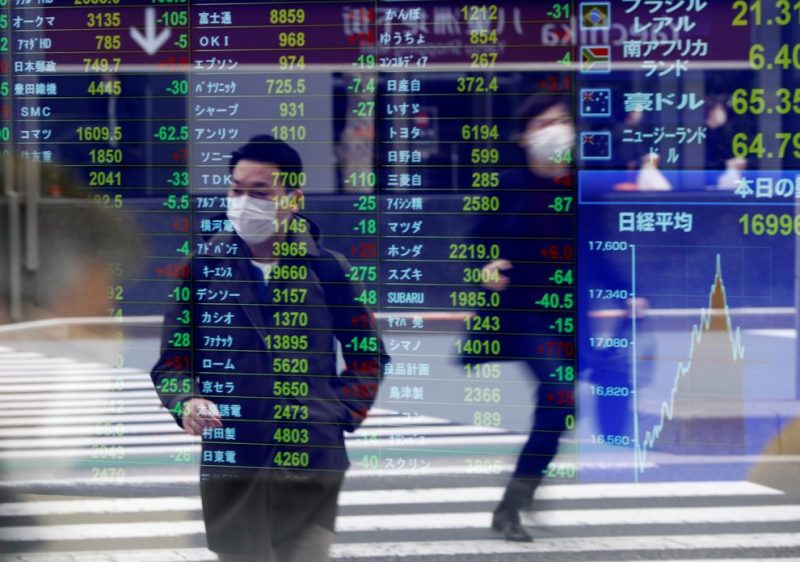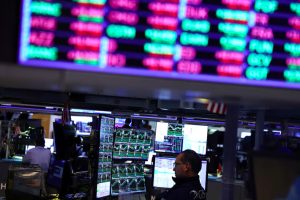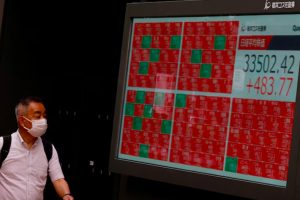Hong Kong stocks nosedived on Monday after its tech firms were hit by news that the country’s technology hub Shenzhen had been put into lockdown, to add to already major concerns about China’s continuing crackdowns on the sector.
Chinese blue chips also shed 1.7% after the jump in coronavirus cases saw the southern city closed off thanks to the authorities’ zero-tolerance approach to the contagion.
City chiefs are carrying out mass testing after dozens of new local cases were recorded and officials have suspended public transport and urged people to work at home.
Also on AF: China Stocks Slump On Coronavirus Spread, Weak Outlook
The Hang Seng Index plunged 4.97%, or 1,022.13 points, to 19,531.66 – dropping below 20,000 for the first time since mid-2016.
The Shanghai Composite Index sank 2.60%, or 86.21 points, to 3,223.53, while the Shenzhen Composite Index on China’s second exchange dived 2.93%, or 63.68 points, to 2,109.46.
But elsewhere most share markets firmed and oil slid on Monday on hopes for progress in Russian-Ukraine peace talks, even as fighting continued to rage, while bond markets braced for rate rises in the United States and UK this week.
Just the chance of peace in eastern Europe saw S&P 500 stock futures add 0.5%, while Nasdaq futures rose 0.4%. EUROSTOXX 50 futures gained 0.5% and FTSE futures 0.2%.
The benchmark Nikkei 225 index climbed 0.58%, or 145.07 points, to end at 25,307.85, while the broader Topix index rose 0.71%, or 12.74 points, to 1,812.28.
Indian stocks rose too and Mumbai’s signature Nifty 50 index was up 1.45%, or 240.85 points, to close at 16,871.30.
But MSCI’s broadest index of Asia-Pacific shares outside Japan was dragged down 1.6% by the losses in China.
Bonds Under Pressure
Bonds elsewhere remained under pressure having taken a beating last week as surging commodity prices looked set to boost inflation further, with yields on 10-year Treasuries rising four basis points to 2.04%.
Notably, a key measure of US inflation expectations climbed to 3% and near record highs.
The Bank of England is expected to lift its rates to 0.75% on Thursday, the third rise in a row, and to signal more with the market pricing an aggressive 2% by year-end.
Fed fund futures imply no less than six or seven hikes this year to around 1.75%, keeping the U.S. dollar underpinned near the highest since May 2020.
Japan’s Energy Dilemma
The Bank of Japan is seen lagging far behind other major central banks in tightening policy.
“The yen has been unable to display its typical safe-haven attributes, partly because of the big rise in US yields and the BoJ yield curve control policy that prevents JGBs following the move up in core global yields,” Rodrigo Catril, a senior FX strategist at NAB, said.
“Japan is also a big energy importer adding to concerns over a terms of trade shock from higher energy prices.”
Gold lost some of its safe-haven charm on Monday, easing 0.5% to $1,975 an ounce and away for last week’s peak at $2,069.
Likewise, the chance of progress on Ukraine saw oil prices surrender a little of their recent gains, even as talks with producer Iran seemed to be stalled.
Brent was last quoted $2.13 lower at $110.54, while U.S. crude fell $2.46 to $106.84.
Key figures around 0820 GMT
Tokyo – Nikkei 225 > UP 0.6% at 25,307.85 (close)
Hong Kong – Hang Seng Index > DOWN 5.0% at 19,531.66 (close)
Shanghai – Composite > DOWN 2.6% at 3,223.53 (close)
London – FTSE 100 > UP 0.2% at 7,170.59
Brent North Sea crude > DOWN 3.2% at $109.02 per barrel
West Texas Intermediate > DOWN 3.6% at $105.37
New York – Dow > DOWN 0.7% at 32,944.19 (close)
- Reuters with additional editing by Sean O’Meara
























